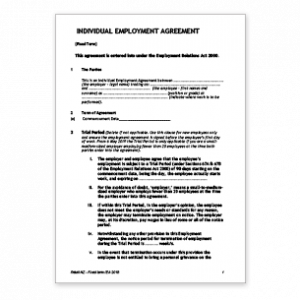Our guidance on using probationary periods
A probationary period can be included in an employment agreement as a way to help assess if an employee is right for the role, before making it permanent. Here’s what you need to know to be compliant if using this clause.
Employees on probation periods still have all the same rights as other employees.
What you need to know to be compliant
- A probationary period is substantially different from a 90-day trial period. A probationary period requires a full HR process before a dismissal occurs.
- For a probationary period to be used in an employment situation, an appropriate probationary clause must be included in the Employment Agreement.
- We recommend that this is signed before the employee begins work but, unlike a 90-day trial period, a probationary period can be negotiated at any stage of employment, if it is agreed to by both you and your employee.
- A probationary period can be used for an existing employee who is taking on a new position within the business, allowing you to determine their suitability for the new role.
- A probationary period can be set for any period of time but must be reasonable given the circumstances of the employer, employee and role.
- The probationary clause must specify the potential outcomes of the probationary period. If the employee is an existing employee moving to a new role, an outcome could be that they return to their substantive position if the probationary period shows they are not meeting the required level of performance for the role. Termination is also a possible outcome.
Our employment agreement templates include a compliant probationary period clause. You can download them below.
Using probationary periods effectively
Most workers don’t start out being perfect from day one. To make the most of the probationary period and truly test the suitability of the person you’ve hired, give your new starter the best chance to succeed by following the below tips.
- Plan a thorough induction that covers all of the employee’s responsibilities and incorporates a variety of resources to help them learn. This may include written documentation, verbal explanations, shadowing more experienced workers, etc.
- Remain available to provide additional support to your employee; allow them opportunities to ask questions or request additional resources and support, if needed.
- Meet your new staff member regularly in the first few weeks to ensure they are fitting in well, understand the job and establish rapport.
- Ensure that you are giving effective, ongoing feedback. Positive feedback encourages employees to continue doing the things they are good at, whilst constructive feedback helps them understand what they can improve.
If the probationary period is unsuccessful
If a probationary period ends with the dismissal of your employee, be aware they can raise a personal grievance if they believe, for example, that you did not have a good reason to dismiss them, they were not given appropriate advice and training on how to do the job effectively, or they weren’t fairly assessed by you.
To avoid risks and to remove any possibility of disadvantage, we suggest the following process be used for any of your employees during a probationary period to ensure you are protecting yourself from any potential personal grievance claim.
After four weeks
After four weeks of employment (or sooner if problems are apparent earlier) arrange to meet with the employee and discuss performance, including both good and not so good aspects of their performance. Describe what you expect during the next weeks for the employee to reach the required standard. Keep a note on the employee’s file about the discussion. Consider if any further training is required and arrange that if necessary.
After eight weeks
After eight weeks of employment (again, sooner if warranted) arrange a further meeting with the employee. If there are still concerns about performance, make it clear to the employee that you are becoming concerned and are considering termination under the probationary clause. Tell the employee that before you make your final decision you would like to meet again in one or two days’ time in a formal meeting to give an opportunity for the employee to ask questions or make suggestions. Invite the employee to bring a support person to the meeting if they wish.
Allow time for consideration
After listening to the employee’s explanation at this meeting, allow sufficient time to consider your decision. If the employee has provided further information that you need to consider or investigate further, allow sufficient time for this. Resume or reschedule the meeting and advise the employee of your decision.
Meet with the employee
You will need to issue a preliminary decision and meet with the employee to consider their final response to your preliminary decision. Again, you will need to adjourn the meeting to consider your employee’s response before confirming your decision or deciding on another course of action.
Deliberate further
If you decide to allow more time to assess performance you still have about four weeks to do that, and in that case, we suggest you call another formal meeting within that time period to make a final decision. You can also propose extending the probationary period further, if you believe there is still potential for the employee to improve their performance. If you decide to extend the probationary period, issue a notification to your employee in writing and specify the new end-date of their probationary period.
Issue letter of dismissal
If you decide to terminate the employment, you should do this according to the notice period set out in the employment agreement. You will decide whether you want the employee to work that notice or leave immediately and be paid wages in lieu of notice. Paying wages in lieu is more common and our standard employment agreement gives you the discretion to do so. Your letter of dismissal should refer to the probationary provision of the employment agreement.
Want more advice?
Please get in touch with our Advice Service on 0800 472 472 (1800 128 086 from Australia) or email [email protected], for templates, questions and guidance on performance management during a probationary period.
Updated November 2024.
















